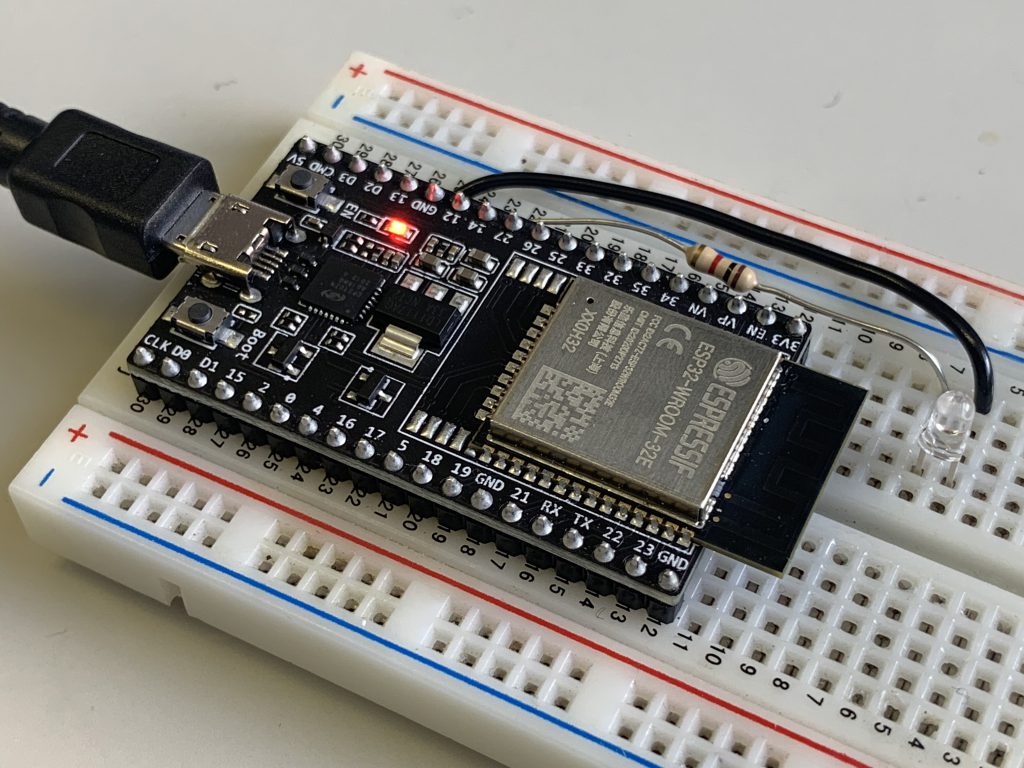
「nRF52840を使ったLowPowerデバイスの開発 その1」の続きです。nRF52840でアドバタイズしたデータを受信してwi-fiでサーバーに送信します。「ESP8266で体温計(ウェアラブルIoT体温計)」でやっていたと同じ事ですが身体に装着する装置を小型にし、電流が必要なwi-fiへの接続を外付けの装置にしています。
ESP32はBLEとwi-fiを両方使えるので今回の用途にはぴったりです。デベロッパーキットをブレッドボードに挿してLEDを付けた簡単電子工作です。LEDは送信確認で光らせているので無しでも出来ます。
nRF52840の体温計を身体に装着し、家のwi-fiが繋がる場所にこのESP32を置きます。BLEの届く範囲で連続して体温を記録することが出来ます。数メートルの範囲内で届いているようです。装置を2Fに置いて1Fでも受信できていました。BLEのスペックとしてはもっと距離が出ても良さそうですが、身体にアンテナが近いのでちょっと難しいようです。
開発にはArduino IDEを使います。
Arduinoスケッチ
/*
2021.05.31 BLE+wifiデータ送信テスト
ESP32 devkit
BLEを受信してデータを受け取った場合にwi-fiに接続してデータをサーバに送信する。
測定間隔はBroadcaster側で決まる
broadCaster はnRF52
*/
#include <Arduino.h>
#include <BLEDevice.h>
#include <WiFi.h>
#include <WiFiMulti.h>
#include <HTTPClient.h>
WiFiMulti wifiMulti;
/* 基本属性定義 */
#define SPI_SPEED 115200 // SPI通信速度
/* スキャン制御用 */
#define DEVICE_NAME "nRF52" // 対象デバイス名
const int scanning_time = 3; // スキャン時間(秒)
BLEScan* pBLEScan; // Scanオブジェクトへのポインター
/* 受信データ構造体 */
struct tmpData {
float temperature; // 温度
};
/* LEDピン */
const int ledPin = 12; // LEDの接続ピン
void setup() {
Serial.begin(SPI_SPEED);
pinMode(ledPin, OUTPUT); // GPIO設定:LED
digitalWrite(ledPin, LOW);
BLEDevice::init(""); // BLEデバイスを作成する
Serial.println("Client application start...");
pBLEScan = BLEDevice::getScan(); // Scanオブジェクトを取得して、
pBLEScan->setActiveScan(false); // パッシブスキャンに設定する
//wifi setup
wifiMulti.addAP("wi-fiのSSID-1", "wi-fiのパスワード-1");
wifiMulti.addAP("wi-fiのSSID-2", "wi-fiのパスワード-2");
wifiMulti.addAP("wi-fiのSSID-3", "wi-fiのパスワード-3");
WiFi.disconnect(true);
WiFi.mode(WIFI_STA);
}
void loop() {
struct tmpData td;
// 所定時間だけスキャンして、見つかったデバイス数を取得する
BLEScanResults foundDevices = pBLEScan->start(scanning_time);
int count = foundDevices.getCount();
for (int i = 0; i < count; i++) { // 受信したアドバタイズデータを調べて
BLEAdvertisedDevice dev = foundDevices.getDevice(i);
std::string mfData = dev.getManufacturerData();
//受信したデータがnRF52からなのかチェックする。その1。データ長をチェック
if (mfData.length() == 5) {
std::string data = dev.getManufacturerData();
// 受信データを調べるnRF52から送信されたデータなのか確認する
if (data[0] == 0xf3 && data[1] == 0 && data[2] == 1) {
//温度を求めて送信へ
td.temperature = (float)(data[4] << 8 | data[3]) / 100.00;
displayData(&td);
//受け取った値が体温らしい温度かどうかチェックする。範囲内なら送信
if (td.temperature > 10.00 && td.temperature < 50.00) {
digitalWrite(ledPin, HIGH);
setndDataToServer(&td);//データを送信する
digitalWrite(ledPin, LOW);
}
}
}
}
delay(1000);
}
/* 受信データを表示する */
void displayData(struct tmpData* td) {
Serial.print(" Temperature: "); Serial.println(td->temperature);
}
/* wi-fiに接続してデータをサーバに送信 */
void setndDataToServer(struct tmpData* td) {
Serial.println("setndDataToServer");
WiFi.disconnect();
if ((wifiMulti.run() == WL_CONNECTED)) {
HTTPClient http;
//体温をStringとして変数に入れる
String tempString = String(td->temperature);
Serial.print("tempString: "); Serial.println(tempString);
//送信するテキスト
String urlString = "http://データ受信用のPHPのURL/tempData.php?temp=" + tempString;
http.begin(urlString); //HTTP
//Serial.print("[HTTP] GET...\n");
// start connection and send HTTP header
int httpCode = http.GET();
// httpCode will be negative on error
if (httpCode > 0) {
// HTTP header has been send and Server response header has been handled
//Serial.printf("[HTTP] GET... code: %d\n", httpCode);
// file found at server
if (httpCode == HTTP_CODE_OK) {
String payload = http.getString();
//Serial.println(payload);
}
} else {
Serial.printf("[HTTP] GET... failed, error: %s\n", http.errorToString(httpCode).c_str());
}
http.end();
} else {
Serial.println("wi-fi connection fail");
}
}wifiMultiを使って複数のwi-fiを登録できます。強度の強いwi-fiに自動的に接続してくれます。自宅と職場とか複数のSSIDを登録して持ち運んで使うとかの用途が考えられます。
BLEでアドバタイズされたデータを受信してデータ長が合致するもので、中身のデータを見てnRF52から送信されたものならサーバーにデータをwi-fiで送信します。本当はUUIDやデバイスネームで識別したいのですが、デバイスネームを取り出せなかったのでデータ長とデータの中身で識別する方法にしてます。
送信されたデータを受信するPHPは以下の通りです。適当なサーバに置いてください。上記のサンプルではhttps:のサーバには繋がらないのでhttp:のサーバーの方が簡単です。
<?php
date_default_timezone_set('Asia/Tokyo');//タイムゾーンの設定
//文字コードの設定
mb_internal_encoding("UTF-8");
$mv = $_GET["temp"];
$fhandle = fopen("./log.csv", "a+");//読み込み/書き出し用でオープンします。 ファイルポインタをファイルの終端
//現在時刻の取得
fwrite($fhandle,date("Y/m/d G:i"));
fwrite($fhandle,",");
fwrite($fhandle,$mv);
fwrite($fhandle, "\n");
//レスポンス
header("Content-type: text/html");
echo "data=";
echo $mv;
echo "C\n";
受信したデータをlog.csvに日付と時刻を追加して追記していくだけです。
データをwebブラウザでグラフ表示するには「ESP8266+CO2モニタ」に書いてあるhtmlとphpが使えますので、そちらを参照してください。
